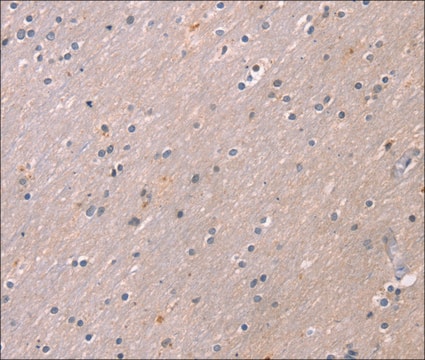K0514
Anti-KCNK9 (TASK-3) antibody, Mouse monoclonal
clone KCN-75, purified from hybridoma cell culture
로그인조직 및 계약 가격 보기
모든 사진(2)
About This Item
결합:
unconjugated
application:
ARR
ELISA (i)
ICC
WB
ELISA (i)
ICC
WB
클론:
KCN-75, monoclonal
종 반응성:
human
citations:
9
기술:
immunocytochemistry: suitable
indirect ELISA: suitable
microarray: suitable
western blot: 4-8 μg/mL using whole extract of cultured T-47D cells (human breast carcinoma)
indirect ELISA: suitable
microarray: suitable
western blot: 4-8 μg/mL using whole extract of cultured T-47D cells (human breast carcinoma)
추천 제품
생물학적 소스
mouse
Quality Level
결합
unconjugated
항체 형태
purified from hybridoma cell culture
항체 생산 유형
primary antibodies
클론
KCN-75, monoclonal
양식
buffered aqueous solution
분자량
antigen ~40 kDa (representing the KCNK9 monomer, and a weaker band at 80 kDa representing the KCNK9 dimer)
종 반응성
human
기술
immunocytochemistry: suitable
indirect ELISA: suitable
microarray: suitable
western blot: 4-8 μg/mL using whole extract of cultured T-47D cells (human breast carcinoma)
동형
IgG2b
UniProt 수납 번호
배송 상태
dry ice
저장 온도
−20°C
타겟 번역 후 변형
unmodified
유전자 정보
human ... KCNK9(51305)
일반 설명
Monoclonal Anti- KCNK9 (TASK-3), Clone KCN-75, (mouse IgG2b isotype) is derived from the KCN-75 hybridoma produced by the fusion of mouse myeloma cells (NS1) and splenocytes from BALB/c mice immunized with a synthetic peptide. Potassium two pore domain channel subfamily K member 9 (KCNK9) gene has been localized to the chromosomal region 8q24.
The gene KCNK9 (potassium two pore domain channel subfamily K member 9), also referred to as TWIK-related acid sensitive K(+) channel-3 (TASK-3), encodes a new member of the K2P (two pore domain K+ channel) family of proteins. It is found to be expressed in several rat tissues, such as brain, kidney, liver, lung, colon, stomach, spleen, testis, and skeletal muscle. It is also expressed to a lesser extent in heart and small intestine. All the potassium channels contain a conserved P domain that is involved in providing K+ selectivity and two, four, or six transmembrane segments.
면역원
synthetic peptide corresponding to amino acids 360-374 in the C-terminus of human KCNK9.
애플리케이션
Anti-KCNK9 (TASK-3) antibody, Mouse monoclonal has been used in:
- immunoblotting
- immunohistochemistry
- immunocytochemistry
생화학적/생리학적 작용
Potassium two pore domain channel subfamily K member 9 (KCNK9) is expressed in carcinomas including breast, lung, colon as well as in metastatic prostate. In 10% of breast cancer patients this gene is amplified, and in 44% the protein is overexpressed.
The gene KCNK9 (potassium two pore domain channel subfamily K member 9) encodes a tandem pore domain potassium channel that dimerizes to form a K+-selective pore. It is highly sensitive to change in pH and is involved in background leak potassium currents found in many cell types. The channel increases the hypoxia tolerance of malignantly transformed cells and facilitates its proliferation and/or survival. It may serve as a potential target for cancer therapies. Mutations in this gene can cause defects in the neuronal migration and have been associated with Birk Barel mental retardation dysmorphism syndrome. This oncogenic potassium channel is found to be expressed in epithelial ovarian cancer and patients with increased expression of this protein have better survival rates.
물리적 형태
Solution in 0.01 M phosphate buffered saline, pH 7.4, containing 15 mM sodium azide.
면책조항
Unless otherwise stated in our catalog or other company documentation accompanying the product(s), our products are intended for research use only and are not to be used for any other purpose, which includes but is not limited to, unauthorized commercial uses, in vitro diagnostic uses, ex vivo or in vivo therapeutic uses or any type of consumption or application to humans or animals.
적합한 제품을 찾을 수 없으신가요?
당사의 제품 선택기 도구.을(를) 시도해 보세요.
Storage Class Code
10 - Combustible liquids
WGK
nwg
Flash Point (°F)
Not applicable
Flash Point (°C)
Not applicable
Genomic amplification and oncogenic properties of the KCNK9 potassium channel gene
Mu D, et al.
Cancer Cell, 3(3), 297-302 (2003)
Expression and prognostic significance of the oncogenic K2P potassium channel KCNK9 (TASK-3) in ovarian carcinoma.
Innamaa A
Anticancer Research, 33, 1401-1408 (2013)
Recovery of current through mutated TASK3 potassium channels underlying Birk Barel syndrome.
Veale EL
Molecular Pharmacology, 85, 397-407 (2014)
TASK-5, a new member of the tandem-pore K(+) channel family.
Kim D and Gnatenco C
Biochemical and Biophysical Research Communications, 284, 923-930 (2001)
TASK-3, a novel tandem pore domain acid-sensitive K+ channel. An extracellular histiding as pH sensor.
Rajan S
The Journal of Biological Chemistry, 275, 16650-16657 (2000)
자사의 과학자팀은 생명 과학, 재료 과학, 화학 합성, 크로마토그래피, 분석 및 기타 많은 영역을 포함한 모든 과학 분야에 경험이 있습니다..
고객지원팀으로 연락바랍니다.






